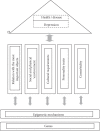Epigenetic Mechanisms in the Neurodevelopmental Theory of Depression
- PMID: 32373361
- PMCID: PMC7196148
- DOI: 10.1155/2020/6357873
Epigenetic Mechanisms in the Neurodevelopmental Theory of Depression
Abstract
The genome (genes), epigenome, and environment work together from the earliest stages of human life to produce a phenotype of human health or disease. Epigenetic modifications, including among other things: DNA methylation, modifications of histones and chromatin structure, as well as functions of noncoding RNA, are coresponsible for specific patterns of gene expression. This refers also to mental disorders, including depressive disorders. Early childhood experiences accompanied by severe stressors (considered a risk factor for depression in adult life) are linked with changes in gene expression. They include genes involved in a response to stress (hypothalamic-pituitary-adrenal axis, HPA), associated with autonomic nervous system hyperactivity and with cortical, and subcortical processes of neuroplasticity and neurodegeneration. These are, among others: gene encoding glucocorticoid receptor, FK506 binding protein 5 gene (FKBP5), gene encoding arginine vasopressin and oestrogen receptor alpha, 5-hydroxy-tryptamine transporter gene (SLC6A4), and gene encoding brain-derived neurotrophic factor. How about personality? Can the experiences unique to every human being, the history of his or her development and gene-environment interactions, through epigenetic mechanisms, shape the features of our personality? Can we pass on these features to future generations? Hence, is the risk of depression inherent in our biological nature? Can we change our destiny?
Copyright © 2020 Monika Talarowska.
Conflict of interest statement
The author(s) declare(s) that they have no conflicts of interest.
Figures
Similar articles
-
[Posttraumatic stress disorder (PTSD) as a consequence of the interaction between an individual genetic susceptibility, a traumatogenic event and a social context].Encephale. 2012 Oct;38(5):373-80. doi: 10.1016/j.encep.2011.12.003. Epub 2012 Jan 24. Encephale. 2012. PMID: 23062450 Review. French.
-
The stress system in the human brain in depression and neurodegeneration.Ageing Res Rev. 2005 May;4(2):141-94. doi: 10.1016/j.arr.2005.03.003. Ageing Res Rev. 2005. PMID: 15996533 Review.
-
DNA methylation differences at the glucocorticoid receptor gene in depression are related to functional alterations in hypothalamic-pituitary-adrenal axis activity and to early life emotional abuse.Psychiatry Res. 2018 Jul;265:341-348. doi: 10.1016/j.psychres.2018.04.064. Epub 2018 May 8. Psychiatry Res. 2018. PMID: 29793048
-
Peripheral DNA methylation of HPA axis-related genes in humans: Cross-tissue convergence, two-year stability and behavioural and neural correlates.Psychoneuroendocrinology. 2018 Nov;97:196-205. doi: 10.1016/j.psyneuen.2018.07.019. Epub 2018 Jul 27. Psychoneuroendocrinology. 2018. PMID: 30059826
-
DNA methylation and expression of stress related genes in PBMC of MDD patients with and without serious suicidal ideation.J Psychiatr Res. 2017 Jun;89:115-124. doi: 10.1016/j.jpsychires.2017.02.005. Epub 2017 Feb 16. J Psychiatr Res. 2017. PMID: 28246044 Free PMC article.
Cited by
-
Vorinostat (SAHA) May Exert Its Antidepressant-Like Effects Through the Modulation of Oxidative Stress Pathways.Neurotox Res. 2021 Apr;39(2):170-181. doi: 10.1007/s12640-020-00317-7. Epub 2021 Jan 5. Neurotox Res. 2021. PMID: 33400178
-
Association of hearing loss and risk of depression: a systematic review and meta-analysis.Front Neurol. 2024 Oct 21;15:1446262. doi: 10.3389/fneur.2024.1446262. eCollection 2024. Front Neurol. 2024. PMID: 39497727 Free PMC article.
-
FKBP5, a Modulator of Stress Responses Involved in Malignant Mesothelioma: The Link between Stress and Cancer.Int J Mol Sci. 2023 May 3;24(9):8183. doi: 10.3390/ijms24098183. Int J Mol Sci. 2023. PMID: 37175892 Free PMC article.
-
Nutrition, Epigenetics, and Major Depressive Disorder: Understanding the Connection.Front Nutr. 2022 May 18;9:867150. doi: 10.3389/fnut.2022.867150. eCollection 2022. Front Nutr. 2022. PMID: 35662945 Free PMC article. Review.
-
Delving Into the Interaction Between Exercise and Diabetes on Methylation of the FKBP5 Gene.J Diabetes Res. 2025 Feb 19;2025:1162708. doi: 10.1155/jdr/1162708. eCollection 2025. J Diabetes Res. 2025. PMID: 40017583 Free PMC article.
References
Publication types
LinkOut - more resources
Full Text Sources
Miscellaneous



